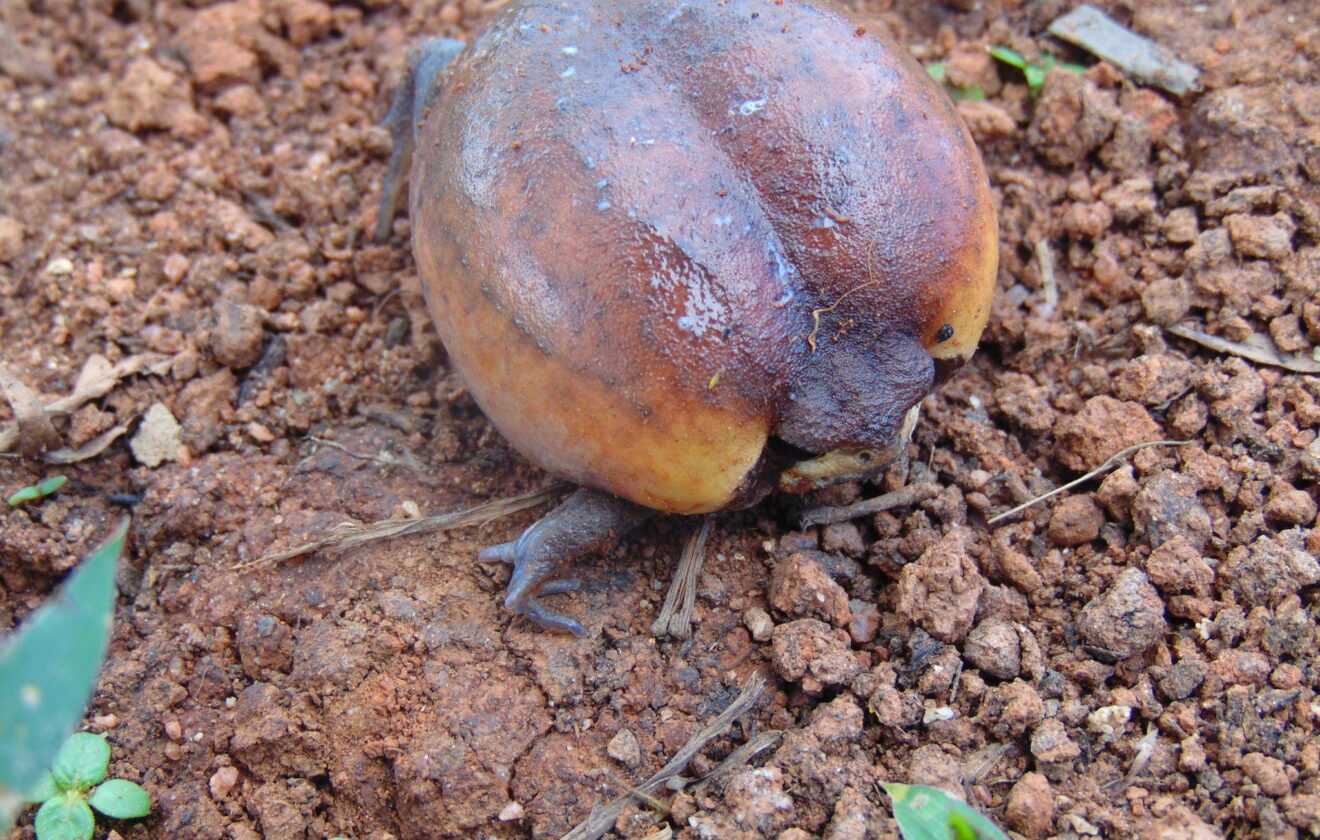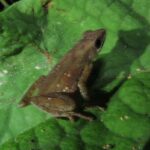Breviceps fichus: Uncovering the Secretive World of a Remarkable Rain Frog#
Deep beneath layers of leaf litter, nestled within the misty highlands of the Tanzanian forests, lives a tiny yet intriguing amphibian whose discreet existence has long captivated the attention of wildlife enthusiasts and scientists alike. Known to scientists as Breviceps fichus, this remarkable species, commonly known as the Tanzanian rain frog, is a peculiar creature, perhaps best appreciated for its rotund build, burrowing lifestyle, and endearing behaviors.
With a comically grumpy expression that amuses researchers and nature lovers, Breviceps fichus manages to be both amusing and fascinating, serving as an unnoticed yet vital player in the ecosystems it inhabits. While frogs in general face numerous ecological challenges today, the nuanced existence of species like this rain frog provides a compelling reminder of the delicate balance within nature’s complexity.
Taxonomy and Classification#
Belonging to the family Brevicipitidae, known broadly as the rain frogs, Breviceps fichus falls within a genus famous for its uniquely round-bodied, burrow-dwelling amphibians. First scientifically described by scientists in recent decades, this species is an excellent representative of evolutionary specialization in the niche-rich realm of East African forests.
Within the genus Breviceps, there exist multiple closely related species, many sharing similar habits, appearances, and habitats. However, careful studies through genetic analysis and distinct vocalizations have confirmed the individuality of Breviceps fichus, highlighting the vibrant biodiversity hidden in Tanzania’s forests and underscoring the critical importance of accurate taxonomic assessment for conservation purposes.
Natural Habitat#
Breviceps fichus‘s range is remarkably restricted, predominantly found within specific montane forests in southeastern Tanzania. These misty highlands, enveloped in dense vegetation and perpetually damp conditions, offer a near-perfect microhabitat for this unique species. Here, vapors funnel through tangled canopies, and densely packed foliage cascades towards the forest floor, creating humid shelters ideal for moisture-dependent amphibians.
These frogs spend most of their existence hidden beneath forest leaf litter or buried beneath soft, wet-soil patches. Highly adapted to subterranean life, Breviceps fichus is rarely encountered above ground unless rainfall prompts its emergence for feeding or breeding. Their preference for these humid, montane ecosystems suggests extreme vulnerability to habitat disturbances such as logging, land clearing, and climate-driven moisture changes—a point of notable concern among conservationists.
Physical Characteristics#
One cannot talk about Breviceps fichus without delving into its charmingly peculiar appearance. Measuring usually not more than 3 centimeters in length, these frogs are distinguished by their notably plump bodies which appear almost spherical, an adaptation ideally suited to their burrowing habit. Their limbs, comparatively short and robust, are well-adapted for digging, enabling efficient passage through loose, damp soils.
Coloration tends toward shades of brown, rust-red, or mottled earth tones, an ideal palette that camouflages them superbly within their foliage-rich environment. Notably, their skins exhibit bumpy textures, and bodies often boast speckled patterns or darker flecks resembling decomposing leaves, further enhancing their protective coloration and ensuring near invisibility to predators.
Interestingly, unlike many frogs, their eyes are relatively small—appropriate for an animal inhabiting predominantly subterranean environments. Powerful stocky legs accompany their powerful burrowing forelimbs, allowing them to anchor themselves securely within burrows and leaf-litter hideaways, enhancing protection against potential predators such as snakes, small mammalian carnivores, and birds.
Behavior and Life Cycle#
As predominantly nocturnal amphibians, the behavior of Breviceps fichus reflects careful adaptation to a hidden lifestyle. Spending the daylight hours securely embedded within soil or leaf litter, they emerge only briefly during cool, damp evenings or after rainstorms, boldly venturing onto the surface in search of their primary diet: tiny invertebrates such as ants, termites, and small spiders. With excellent sensory systems adept at detecting subtle vibrations, these frogs expertly track and capture prey through rapid, accurate strikes of their sticky tongues.
An Unusual Breeding Behavior#
The breeding ecology of Breviceps fichus sets it apart from many of its amphibian kin. Unlike frogs that flock to water bodies to deposit eggs, this species practices a specialized terrestrial breeding strategy. Potential mates are attracted through a gently nasal, trilling call emitted by males from covered burrows or leaf-covered hideaways. When females respond, the male employs subtle movements and vocalizations in a complex courting ritual.
After successful pairing, the female creates a carefully prepared cocoon-like burrow chamber, typically beneath the moist soil or within decaying wood piles. Eggs—laid in small clusters—forego the typical aquatic tadpole stage entirely. Instead, development occurs entirely within the egg, enveloped by nutrients and fluids vital for embryonic growth. This fascinating adaptation, known as direct development, ensures their young hatch as fully-formed miniature adults, immediately ready to engage in their secretive, fossorial lifestyle.
Ecological Role#
Though modest and hidden, Breviceps fichus serves important ecological functions within its forest ecosystem. As predators of soil and leaf-dwelling invertebrates, these frogs help manage populations of insects and arachnids that could otherwise grow unchecked, disrupting ecological balances and negatively influencing vegetation health.
In addition, their own presence provides food sources for other animals, becoming integral members of the dietary regime of certain snakes, birds, and mammals. Their role extends beyond direct predator and prey interactions, as amphibians like Breviceps fichus serve scientifically recognized importance as valuable ecological indicators. Their sensitivity to subtle environmental changes make them accurate early warning signals for threats such as pollution, habitat degradation, and changing climatic conditions.
Threats and Conservation Status#
Sadly, despite their ecological relevance and inherent intrigue, Breviceps fichus frogs face substantial threats from habitat destruction, primarily due to deforestation, agricultural expansion, and urban development. Additionally, climate change increasingly threatens their highly specific habitat conditions, jeopardizing the delicate humidity balance required for their survival.
Although not yet globally assessed by the IUCN Red List due to limited data, local observations suggest population declines in most areas studied. Conservationists advocating within Tanzania have thus urged the protection of highland forest habitats, recognizing that safeguarding these ecosystems goes hand in hand with securing a stable future for these unique amphibians. Efforts directed toward habitat preservation, ecological awareness and sustainable forestry practices are therefore elemental to Breviceps fichus‘ continued survival.
Cultural and Scientific Significance#
While modest in cultural prominence compared to larger charismatic fauna, local communities have traditionally respected frogs—including rain frogs like Breviceps fichus—as symbols of environmental fertility and rainfall abundance. Villagers in some East African regions see the appearance and repetitive croaking of frogs as welcome omens for agricultural seasons ahead.
Scientifically, Breviceps fichus contributes significantly by illustrating the broader principles of species specialization, adaptive radiation, and ecological interdependence. By understanding their particular ecological niches and sensitivity to environmental stressors, scientists gain clues that inform broader conservation strategies applicable to similar small-scale, specialized amphibians worldwide.
Conclusion#
Though small and easily overlooked, the Tanzanian rain frog Breviceps fichus is an eloquent ambassador for biodiversity, specialization, and ecological complexity. By understanding and appreciating species like this diminutive, endearing amphibian, readers, conservationists, policy-makers, and scientists alike can forge lasting connections between broader environmental protection and individual species conservation.
Ultimately, the survival and prosperity of unique creatures such as Breviceps fichus depends significantly upon humanity’s informed stewardship of the habitats they call home. Through mindful ecological action, awareness, and support of conservation efforts, we can ensure that Breviceps fichus‘s signature trill continues to resonate softly through the forests of Tanzania, celebrating a species that, despite its diminutive stature, embodies innate harmony with its environment.








